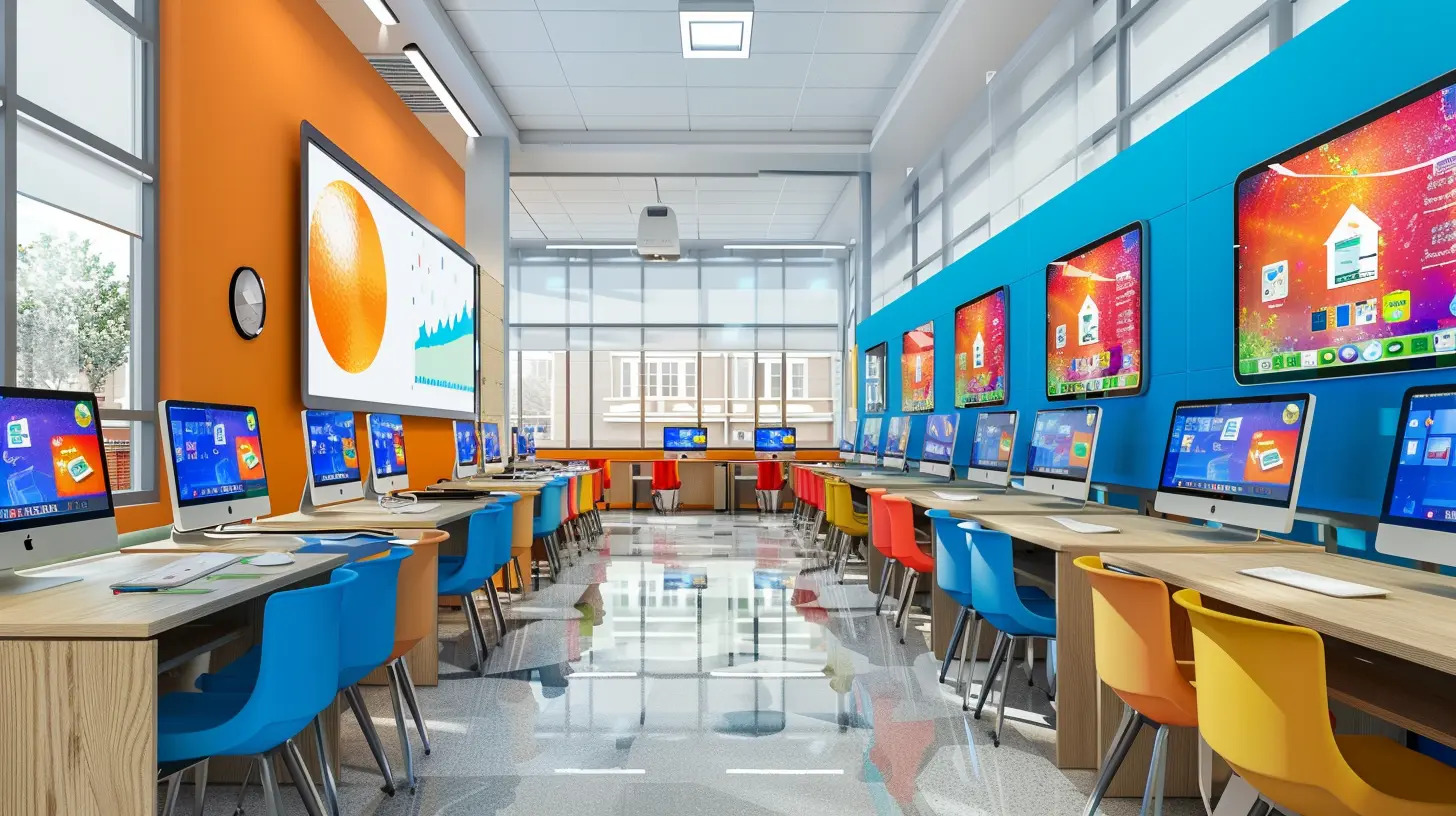How to Create an Interactive Learning Environment with Technology"
26 July 2025
In today’s rapidly evolving digital world, the way we learn and teach is undergoing a significant transformation. Gone are the days where static textbooks and lectures were the only tools at our disposal. Now, more than ever, technology plays a pivotal role in shaping the educational experience. But here's the question: How can we use technology to create an interactive learning environment that not only grabs students' attention but also enhances their overall learning experience? Well, buckle up! In this guide, we'll dive deep into the ways you can harness the power of technology to make learning more engaging, interactive, and effective.

Why Interactive Learning Matters
Before we get into the nuts and bolts of how to create an interactive learning environment using technology, let's take a step back and ask ourselves: Why does interactive learning matter in the first place?Think about it. If you’re sitting through a boring lecture or slogging through pages of a textbook, how much are you really absorbing? Not much, right? Now, compare that to an interactive setting where you can ask questions, participate in discussions, engage with content in various formats, and even apply what you learn in real-time. Sounds more interesting, doesn’t it?
Interactive learning does more than just keep students engaged—it fosters critical thinking, encourages collaboration, and helps students retain information better. Studies show that learners retain 75% of the information when they actively participate in the learning process, as opposed to just 5-10% when they're passively listening or reading. That’s a huge difference!
So, how do we create that kind of environment, especially when we have technology at our fingertips? Let’s break it down.

1. Leverage Interactive Tools and Platforms
a. Learning Management Systems (LMS)
One of the first steps to creating an interactive learning environment is using a Learning Management System (LMS). An LMS like Google Classroom, Moodle, or Canvas allows educators to organize and deliver content in a more engaging and structured way. These platforms provide tools that allow students to participate in discussions, submit assignments, take quizzes, and even collaborate on projects.What’s cool about an LMS is that it’s not just a one-way street. Students can leave comments, ask questions, and even interact with their peers. This creates a dynamic learning environment where everyone is involved.
b. Gamification Platforms
Let’s be real—who doesn’t love a good game? Gamification is a fantastic way to make learning fun and interactive. Platforms like Kahoot! and Quizizz turn quizzes and lessons into games where students can compete with each other in real-time. The competitive element adds an extra layer of excitement, and students are more motivated to pay attention.Gamification doesn’t just apply to quizzes. You can also gamify learning progress using apps like Classcraft, where students earn points and rewards based on their academic achievements and classroom behavior.
c. Virtual Reality (VR) and Augmented Reality (AR)
If you really want to take interactive learning to the next level, consider using Virtual Reality (VR) and Augmented Reality (AR). With VR, students can immerse themselves in 3D environments—whether it's walking through ancient Rome, exploring the human body, or even visiting outer space! AR, on the other hand, overlays virtual elements onto the real world, which can be used to bring textbooks and learning materials to life.Apps like Google Expeditions and Nearpod VR enable educators to create virtual field trips, making learning immersive and hands-on. These tools not only grab students’ attention but also enhance their understanding of complex concepts through visualization.

2. Create Collaborative Learning Spaces
a. Cloud-Based Collaboration Tools
One of the best things about technology is its ability to connect people—no matter where they are. Using cloud-based tools like Google Docs, Microsoft Teams, or Slack, students can collaborate on projects in real-time. They can edit documents, share ideas, and communicate with each other seamlessly.For instance, if you’ve ever worked on a group project using Google Docs, you know how easy it is to make changes and leave comments for your teammates. This level of interaction fosters teamwork and helps students learn from each other.
b. Discussion Boards and Forums
Another great way to encourage interaction is through online discussion boards or forums. Platforms like Piazza or the built-in forums in LMS tools allow students to ask questions, share insights, and discuss topics with their peers. The beauty of forums is that they provide a space for students who might be too shy to speak up in class to voice their opinions.Plus, discussions don’t have to be limited to classroom hours. Students can contribute to discussions anytime, which makes learning an ongoing process.
c. Peer-to-Peer Learning
Interactive learning isn’t just about students learning from the teacher—it’s also about learning from each other. Encourage peer-to-peer learning by having students work on group projects, engage in peer reviews, or even teach certain topics to the class. Platforms like Flipgrid allow students to create video presentations that they can share with their peers, fostering a more interactive and collaborative learning experience.
3. Incorporate Multimedia Content
Let’s face it: text-heavy content can be boring. To create a truly interactive learning environment, you need to mix things up by incorporating multimedia. This includes videos, podcasts, infographics, and even interactive simulations.a. Educational Videos
Platforms like YouTube, Khan Academy, and TED-Ed offer a wealth of educational videos on practically any subject. These videos can break down complex concepts into bite-sized, easy-to-digest pieces. Plus, they appeal to visual learners who might struggle with traditional text-based content.You can even create your own videos using tools like Screencast-O-Matic or Loom to explain difficult topics or walk students through assignments. Just imagine being able to pause, rewind, and rewatch lessons at your own pace—pretty handy, right?
b. Interactive Simulations
For subjects like science, math, or history, interactive simulations can be game-changers. Websites like PhET Interactive Simulations offer free tools where students can tinker with variables, run experiments, and see real-time results. This hands-on approach not only makes learning more interactive but also helps students understand complex concepts through experimentation.c. Podcasts and Audio Content
Not all students learn the same way. Some are auditory learners who benefit from listening to content rather than reading or watching. Incorporating podcasts or audio lessons into your curriculum can provide a different avenue for learning. Apps like Spotify or Audible have a variety of educational podcasts that can complement your lessons.4. Use Assessment Tools for Real-Time Feedback
One of the key aspects of interactive learning is the ability to get real-time feedback. Traditional assessments like exams or quizzes often provide feedback after the fact, but with technology, you can provide instantaneous feedback that helps students understand their mistakes and learn from them.a. Interactive Quizzes and Polls
Tools like Socrative, Mentimeter, or Google Forms allow you to create quizzes and polls where students can see their results immediately. This instant feedback can be a powerful motivator, as students can track their progress and see where they need improvement.b. Adaptive Learning Platforms
Adaptive learning platforms like Knewton or DreamBox use algorithms to tailor lessons and assessments to the individual needs of each student. As students answer questions, the platform adjusts the difficulty level based on their performance. This personalized approach ensures that students are constantly challenged at the right level, making learning more engaging and effective.
5. Encourage Active Participation
Finally, the most important ingredient in an interactive learning environment is active participation. Technology can help facilitate this, but it’s up to the educator to create a culture where students feel comfortable and motivated to engage.a. Flipped Classroom Model
One way to do this is by adopting a flipped classroom model, where students review the lesson materials (videos, readings, etc.) at home and then come to class ready to discuss, ask questions, and engage in hands-on activities. This flips the traditional model on its head—rather than passively listening to a lecture, students are actively involved in the learning process.b. Interactive Whiteboards
Interactive whiteboards like SMART Boards or even apps like Jamboard allow students to actively participate in lessons by drawing, writing, and solving problems directly on the screen. This turns a passive lecture into a dynamic, interactive session where students can contribute in real-time.Final Thoughts
Creating an interactive learning environment with technology is not just about using the latest gadgets or software—it’s about fostering meaningful engagement, collaboration, and participation. Whether it’s through gamification, multimedia content, or real-time feedback, the goal is to make learning a dynamic, hands-on experience that keeps students invested in their education.The beauty of technology is that it can be adapted to suit the needs of any classroom or learning style. So, why not embrace the possibilities and start transforming your learning environment today?
all images in this post were generated using AI tools
Category:
Classroom TechnologyAuthor:

Olivia Lewis
Discussion
rate this article
1 comments
Morgan Rios
Great tips! Embracing technology can really make learning exciting and engaging for everyone involved. Thanks!
August 7, 2025 at 1:01 PM

Olivia Lewis
Thank you! I'm glad you found the tips helpful. Embracing technology truly enhances the learning experience!


